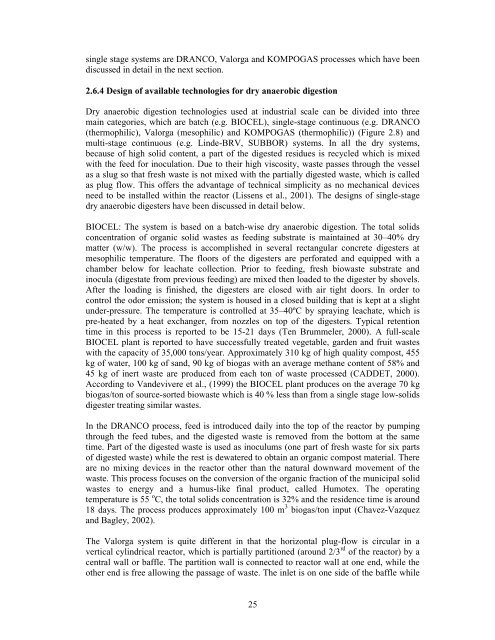dry anaerobic digestion of municipal solid waste and digestate ...
dry anaerobic digestion of municipal solid waste and digestate ...
dry anaerobic digestion of municipal solid waste and digestate ...
You also want an ePaper? Increase the reach of your titles
YUMPU automatically turns print PDFs into web optimized ePapers that Google loves.
single stage systems are DRANCO, Valorga <strong>and</strong> KOMPOGAS processes which have been<br />
discussed in detail in the next section.<br />
2.6.4 Design <strong>of</strong> available technologies for <strong>dry</strong> <strong>anaerobic</strong> <strong>digestion</strong><br />
Dry <strong>anaerobic</strong> <strong>digestion</strong> technologies used at industrial scale can be divided into three<br />
main categories, which are batch (e.g. BIOCEL), single-stage continuous (e.g. DRANCO<br />
(thermophilic), Valorga (mesophilic) <strong>and</strong> KOMPOGAS (thermophilic)) (Figure 2.8) <strong>and</strong><br />
multi-stage continuous (e.g. Linde -BRV, SUBBOR) systems. In all the <strong>dry</strong> systems,<br />
because <strong>of</strong> high <strong>solid</strong> content, a part <strong>of</strong> the digested residues is recycled which is mixed<br />
with the feed for inoculation. Due to their high viscosity, <strong>waste</strong> passes through the vessel<br />
as a slug so that fresh <strong>waste</strong> is not mixed with the partially digested <strong>waste</strong>, which is called<br />
as plug flow. This <strong>of</strong>fers the advantage <strong>of</strong> technical simplicity as no mechanical devices<br />
need to be installed within the reactor (Lissens et al., 2001). The designs <strong>of</strong> single-stage<br />
<strong>dry</strong> <strong>anaerobic</strong> digesters have been discussed in detail below.<br />
BIOCEL: The system is based on a batch-wise <strong>dry</strong> <strong>anaerobic</strong> <strong>digestion</strong>. The total <strong>solid</strong>s<br />
concentration <strong>of</strong> organic <strong>solid</strong> <strong>waste</strong>s as feeding substrate is maintained at 30–40% <strong>dry</strong><br />
matter (w/w). The process is accomplished in several rectangular concrete digesters at<br />
mesophilic temperature. The floors <strong>of</strong> the digesters are perforated <strong>and</strong> equipped with a<br />
chamber below for leachate collection. Prior to feeding, fresh bio<strong>waste</strong> substrate <strong>and</strong><br />
inocula (<strong>digestate</strong> from previous feeding) are mixed then loaded to the digester by shovels.<br />
After the loading is finished, the digesters are closed with air tight doors. In order to<br />
control the odor emission; the system is housed in a closed building that is kept at a slight<br />
under-pressure. The temperature is controlled at 35–40ºC by spraying leachate, which is<br />
pre-heated by a heat exchanger, from nozzles on top <strong>of</strong> the digesters. Typical retention<br />
time in this process is reported to be 15-21 days ( Ten Brummeler, 2000). A full-scale<br />
BIOCEL plant is reported to have successfully treated vegetable, garden <strong>and</strong> fruit <strong>waste</strong>s<br />
with the capacity <strong>of</strong> 35,000 tons/year. Approximately 310 kg <strong>of</strong> high quality compost, 455<br />
kg <strong>of</strong> water, 100 kg <strong>of</strong> s<strong>and</strong>, 90 kg <strong>of</strong> biogas with an average methane content <strong>of</strong> 58% <strong>and</strong><br />
45 kg <strong>of</strong> inert <strong>waste</strong> are produced from each ton <strong>of</strong> <strong>waste</strong> processed (CADDET, 2000).<br />
According to V<strong>and</strong>evivere et al., (1999) the BIOCEL plant produces on the average 70 kg<br />
biogas/ton <strong>of</strong> source-sorted bio<strong>waste</strong> which is 40 % less than from a single stage low-<strong>solid</strong>s<br />
digester treating similar <strong>waste</strong>s.<br />
In the DRANCO process, feed is introduced daily into the top <strong>of</strong> the reactor by pumping<br />
through the feed tubes, <strong>and</strong> the digested <strong>waste</strong> is removed from the bottom at the same<br />
time. Part <strong>of</strong> the digested <strong>waste</strong> is used as inoculums (one part <strong>of</strong> fresh <strong>waste</strong> for six parts<br />
<strong>of</strong> digested <strong>waste</strong>) while the rest is dewatered to obtain an organic compost material. There<br />
are no mixing devices in the reactor other than the natural downward movement <strong>of</strong> the<br />
<strong>waste</strong>. This process focuses on the conversion <strong>of</strong> the organic fraction <strong>of</strong> the <strong>municipal</strong> <strong>solid</strong><br />
<strong>waste</strong>s to energy <strong>and</strong> a humus-like final product, called Humotex. The operating<br />
temperature is 55 o C, the total <strong>solid</strong>s concentration is 32% <strong>and</strong> the residence time is around<br />
18 days. The process produces approximately 100 m 3 biogas/ton input (Chavez-Vazquez<br />
<strong>and</strong> Bagley, 2002).<br />
The Valorga system is quite different in that the horizontal plug-flow is circular in a<br />
vertical cylindrical reactor, which is partially partitioned (around 2/3 rd <strong>of</strong> the reactor) by a<br />
central wall or baffle. The partition wall is connected to reactor wall at one end, while the<br />
other end is free allowing the passage <strong>of</strong> <strong>waste</strong>. The inlet is on one side <strong>of</strong> the baffle while<br />
25

















